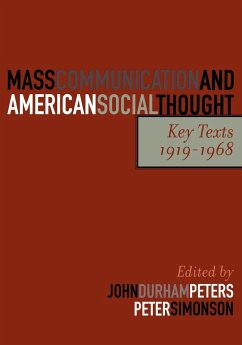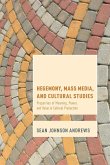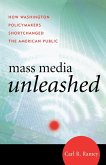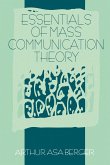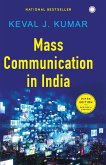Mass Communication and American Social Thought
Key Texts, 1919-1968
Herausgeber: Peters, John Durham; Simonson, Peter
Mass Communication and American Social Thought
Key Texts, 1919-1968
Herausgeber: Peters, John Durham; Simonson, Peter
- Broschiertes Buch
- Merkliste
- Auf die Merkliste
- Bewerten Bewerten
- Teilen
- Produkt teilen
- Produkterinnerung
- Produkterinnerung
This anthology of hard-to-find primary documents provides a solid overview of the foundations of American media studies. Focusing on mass communication and society and how this research fits into larger patterns of social thought, this valuable collection features key texts covering the media studies traditions of the Chicago school, the effects tradition, the critical theory of the Frankfurt school, and mass society theory. Where possible, articles are reproduced in their entirety to preserve the historical flavor and texture of the original works. Topics include popular theater, yellow…mehr
Andere Kunden interessierten sich auch für
![Hegemony, Mass Media and Cultural Studies Hegemony, Mass Media and Cultural Studies]() Sean Johnson AndrewsHegemony, Mass Media and Cultural Studies55,99 €
Sean Johnson AndrewsHegemony, Mass Media and Cultural Studies55,99 €![Mass Media Unleashed Mass Media Unleashed]() Carl R. RameyMass Media Unleashed54,99 €
Carl R. RameyMass Media Unleashed54,99 €![A Handbook of Qualitative Methodologies for Mass Communication Research A Handbook of Qualitative Methodologies for Mass Communication Research]() Nicholas W. Jankowski (ed.)A Handbook of Qualitative Methodologies for Mass Communication Research57,99 €
Nicholas W. Jankowski (ed.)A Handbook of Qualitative Methodologies for Mass Communication Research57,99 €![Essentials of Mass Communication Theory Essentials of Mass Communication Theory]() Arthur Asa BergerEssentials of Mass Communication Theory95,99 €
Arthur Asa BergerEssentials of Mass Communication Theory95,99 €![Mass Communication in India, Fifth Edition Mass Communication in India, Fifth Edition]() Keval J. KumarMass Communication in India, Fifth Edition49,99 €
Keval J. KumarMass Communication in India, Fifth Edition49,99 €![American Mass Media and Popular Culture American Mass Media and Popular Culture]() American Mass Media and Popular Culture122,99 €
American Mass Media and Popular Culture122,99 €![Social Foundations of the Mass Media Social Foundations of the Mass Media]() Walter M. BraschSocial Foundations of the Mass Media75,99 €
Walter M. BraschSocial Foundations of the Mass Media75,99 €-
-
-
This anthology of hard-to-find primary documents provides a solid overview of the foundations of American media studies. Focusing on mass communication and society and how this research fits into larger patterns of social thought, this valuable collection features key texts covering the media studies traditions of the Chicago school, the effects tradition, the critical theory of the Frankfurt school, and mass society theory. Where possible, articles are reproduced in their entirety to preserve the historical flavor and texture of the original works. Topics include popular theater, yellow journalism, cinema, books, public relations, political and military propaganda, advertising, opinion polling, photography, the avant-garde, popular magazines, comics, the urban press, radio drama, soap opera, popular music, and television drama and news. This text is ideal for upper-level courses in mass communication and media theory, media and society, mass communication effects, and mass media history.
Produktdetails
- Produktdetails
- Verlag: Rowman & Littlefield Publishers
- Seitenzahl: 548
- Erscheinungstermin: 3. August 2004
- Englisch
- Abmessung: 254mm x 178mm x 29mm
- Gewicht: 1018g
- ISBN-13: 9780742528390
- ISBN-10: 0742528391
- Artikelnr.: 21484587
- Herstellerkennzeichnung
- Libri GmbH
- Europaallee 1
- 36244 Bad Hersfeld
- gpsr@libri.de
- Verlag: Rowman & Littlefield Publishers
- Seitenzahl: 548
- Erscheinungstermin: 3. August 2004
- Englisch
- Abmessung: 254mm x 178mm x 29mm
- Gewicht: 1018g
- ISBN-13: 9780742528390
- ISBN-10: 0742528391
- Artikelnr.: 21484587
- Herstellerkennzeichnung
- Libri GmbH
- Europaallee 1
- 36244 Bad Hersfeld
- gpsr@libri.de
John Durham Peters is F. Wendell Miller Distinguished Professor in the Department of Communication Studies at the University of Iowa. Peter Simonson is assistant professor of communication at the University of Pittsburgh.
Chapter 1 Introduction: Mass Communication and American Social Thought: Key
Texts, 1919-1968
Part 2 Part I From Hope to Disillusionment: Mass Communication Theory
Coalesces, 1919-1933
Chapter 3 1 "The Process of Social Change," from Political Science
Quarterly (1897)
Chapter 4 2 "The House of Dreams," from The Spirit of Youth and the City
Streets (1909)
Chapter 5 3 From Winesburg, Ohio (1919)
Chapter 6 4 From Introduction to the Science of Sociology (1921)
Chapter 7 5 "Nature, Communication, and Meaning," from Experience and
Nature (1925)
Chapter 8 6 "The Disenchanted Man," from The Phantom Public (1925)
Chapter 9 7 "Criteria of Negro Art," from Crisis Magazine (1926)
Chapter 10 8 "The Results of Propaganda," from Propaganda Technique in the
World War (1927)
Chapter 11 9 "Manipulating Public Opinion: The Why and the How" (1928)
Chapter 12 10 From Middletown: A Study in Contemporary American Culture
(1929)
Chapter 13 11 "Communication," from Encyclopaedia of the Social Sciences
(1931)
Part 14 Part II The World in Turmoil: Communications Research, 1933-1949
Chapter 15 12 "Conclusion," from Movies and Conduct (1933)
Chapter 16 13 "The Integration of Communication," from Communication
Agencies and Social Life (1933)
Chapter 17 14 "Toward a Critique of Negro Music," from Opportunity (1934)
Chapter 18 15 From Technics and Civilization (1934)
Chapter 19 16 "The Business Nobody Knows," from Our Master's Voice (1934)
Chapter 20 17 "The Influence of Radio upon Mental and Social Life," from
The Psychology of Radio (1935)
Chapter 21 18 "Foreword," from Public Opinion Quarterly (1937)
Chapter 22 19 "Human Interest Stories and Democracy," from Public Opinion
Quarterly (1937)
Chapter 23 20 From The Fine Art of Propaganda (1939)
Chapter 24 21 "A Powerful, Bold, and Unmeasurable Party?" from The Pulse of
Democracy (1940)
Chapter 25 22 "Democracy in Reverse," from Public Opinion Quarterly (1940)
Chapter 26 23 "Needed Research in Communication," from the Rockefeller
Archives (1940)
Chapter 27 24 "On Borrowed Experience: An Analysis of Listening to Daytime
Sketches," from Studies in Philosophy and Social Science (1941)
Chapter 28 25 "Art and Mass Culture," from Studies in Philosophy and Social
Science (1941)
Chapter 29 26 "Administrative and Critical Communications Research," from
Studies in Philosophy and Social Science (1941)
Chapter 30 27 "The Popular Music Industry," from Radio Research 1941
(1942)
Chapter 31 28 From Dialectic of Enlightenment (1944)
Chapter 32 29 "Nazi Propaganda and Violence," from German Radio Propaganda
(1944)
Chapter 33 30 "Biographies in Popular Magazines," from Radio Research
1942-1943 (1944)
Chapter 34 31 "The Negro Press," from An American Dilemma: The Negro
Problem and Modern Democracy (1944)
Chapter 35 32 "A Social Critique of Radio Music," from the Kenyon Review
(1945)
Chapter 36 33 "The Social and Cultural Context," from Mass Persuasion
(1946)
Chapter 37 34 "The Requirements," from A Free and Responsible Press (1947)
Chapter 38 35 "Mass Media," from UNESCO: Its Philosophy and Purpose (1947)
Chapter 39 36 "The Enormous Radio," from The Enormous Radio and Other
Stories (1947)
Chapter 40 37 "Mass Communication, Popular Taste, and Organized Social
Action," from The Communication of Ideas (1948)
Chapter 41 38 Table from "Communication Research and the Social
Psychologist," from Current Trends in Social Psychology (1948)
Chapter 42 39 "Information, Language, and Society," from Cybernetics:
Control and Communication in the Animal and the Machine (1948)
Chapter 43 40 "Consensus and Mass Communication," from American
Sociological Review (1948)
Chapter 44 41 "What 'Missing the Newspaper' Means," from Communications
Research (1949)
Part 45 Part III The American Dream and Its Discontents: Mass Communication
Theory, 1949-1968
Chapter 46 42 "Industrialism and Cultural Values," from The Bias of
Communication (1950)
Chapter 47 43 "Emerging from Magic," from Hollywood: The Dream Factory
(1950)
Chapter 48 44 "Storytellers as Tutors in technique," from The Lonely Crowd
(1950)
Chapter 49 45 "Our Next Frontier. . .Transoceanic TV," from Look (1950)
Chapter 50 46 "Communication in the Sovietized State, as Demonstrated in
Korea," from Public Opinion Quarterly (1951)
Chapter 51 47 "The Consumer's Stake in Radio and Television," from
Quarterly of Film, Radio and Television (1951)
Chapter 52 48 "The Unique Perspective of Television and Its Effect," from
American Sociological Review (1952)
Chapter 53 49 "Technology and Political Change," from International Journal
(1952)
Chapter 54 50 "A Theory of Mass Culture," from Diogenes (1953)
Chapter 55 51 "Sight, Sound, and Fury," from Commonweal (1954)
Chapter 56 52 "Between Media and Mass," from Personal Influence (1955)
Chapter 57 53 "The Theory of Mass Society: A Critique," from Commentary
(1956)
Chapter 58 54 "Mass Communication and Para-Social Interaction: Observations
on Intimacy at a Distance," from Psychiatry (1956)
Chapter 59 55 "The Mass Society," from The Power Elite (1956)
Chapter 60 56 "FDR and the White House Mail," Public Opinion Quarterly
(1956)
Chapter 61 57 "Notes on a Natural History of Fads," from American Journal
of Sociology (1957)
Chapter 62 58 "Mass Communication and Socio-cultural Integration," from
Social Forces (1958)
Chapter 63 59 "Modernizing Styles of Life: A Theory," from The Passing of
Traditional Society (1958)
Chapter 64 60 "The Social-Anatomy of the Romance-Confession Cover Girl,"
from Journalism Quarterly (1959)
Chapter 65 61 "The State of Communication Research," from Public Opinion
Quarterly (1959)
Chapter 66 62 "The State of Communication Research: Comments," from Public
Opinion Quarterly (1959)
Chapter 67 63 "What is Mass Communication?" from Mass Communication: A
Sociological Perspective (1959)
Chapter 68 64 "Social Theory and Mass Media," from Canadian Journal of
Economics and Political Science (1961)
Chapter 69 65 "Television and Public Interest" (1961)
Chapter 70 66 "The Kennedy Assassination and the Nature of Political
Commitment," from The Kennedy Assassination and the American Public (1965)
Chapter 71 67 "TV Overseas:The U.S. Hard Sell," from The Nation (1966)
Chapter 72 68 "Aggressiveness in Advanced Industrial Societies," from
Negations (1968)
Chapter 73 Afterword and Acknowledgements
Chapter 74 Other Readers and Historical Collections in American Mass
Communication Study and Related Subjects
Chapter 75 Suggested Films
Chapter 76 Select Supplementary Reading List
Chapter 77 The Intellectual History of North American Media Studies,
1919-1968: A Selected Bibliography
Texts, 1919-1968
Part 2 Part I From Hope to Disillusionment: Mass Communication Theory
Coalesces, 1919-1933
Chapter 3 1 "The Process of Social Change," from Political Science
Quarterly (1897)
Chapter 4 2 "The House of Dreams," from The Spirit of Youth and the City
Streets (1909)
Chapter 5 3 From Winesburg, Ohio (1919)
Chapter 6 4 From Introduction to the Science of Sociology (1921)
Chapter 7 5 "Nature, Communication, and Meaning," from Experience and
Nature (1925)
Chapter 8 6 "The Disenchanted Man," from The Phantom Public (1925)
Chapter 9 7 "Criteria of Negro Art," from Crisis Magazine (1926)
Chapter 10 8 "The Results of Propaganda," from Propaganda Technique in the
World War (1927)
Chapter 11 9 "Manipulating Public Opinion: The Why and the How" (1928)
Chapter 12 10 From Middletown: A Study in Contemporary American Culture
(1929)
Chapter 13 11 "Communication," from Encyclopaedia of the Social Sciences
(1931)
Part 14 Part II The World in Turmoil: Communications Research, 1933-1949
Chapter 15 12 "Conclusion," from Movies and Conduct (1933)
Chapter 16 13 "The Integration of Communication," from Communication
Agencies and Social Life (1933)
Chapter 17 14 "Toward a Critique of Negro Music," from Opportunity (1934)
Chapter 18 15 From Technics and Civilization (1934)
Chapter 19 16 "The Business Nobody Knows," from Our Master's Voice (1934)
Chapter 20 17 "The Influence of Radio upon Mental and Social Life," from
The Psychology of Radio (1935)
Chapter 21 18 "Foreword," from Public Opinion Quarterly (1937)
Chapter 22 19 "Human Interest Stories and Democracy," from Public Opinion
Quarterly (1937)
Chapter 23 20 From The Fine Art of Propaganda (1939)
Chapter 24 21 "A Powerful, Bold, and Unmeasurable Party?" from The Pulse of
Democracy (1940)
Chapter 25 22 "Democracy in Reverse," from Public Opinion Quarterly (1940)
Chapter 26 23 "Needed Research in Communication," from the Rockefeller
Archives (1940)
Chapter 27 24 "On Borrowed Experience: An Analysis of Listening to Daytime
Sketches," from Studies in Philosophy and Social Science (1941)
Chapter 28 25 "Art and Mass Culture," from Studies in Philosophy and Social
Science (1941)
Chapter 29 26 "Administrative and Critical Communications Research," from
Studies in Philosophy and Social Science (1941)
Chapter 30 27 "The Popular Music Industry," from Radio Research 1941
(1942)
Chapter 31 28 From Dialectic of Enlightenment (1944)
Chapter 32 29 "Nazi Propaganda and Violence," from German Radio Propaganda
(1944)
Chapter 33 30 "Biographies in Popular Magazines," from Radio Research
1942-1943 (1944)
Chapter 34 31 "The Negro Press," from An American Dilemma: The Negro
Problem and Modern Democracy (1944)
Chapter 35 32 "A Social Critique of Radio Music," from the Kenyon Review
(1945)
Chapter 36 33 "The Social and Cultural Context," from Mass Persuasion
(1946)
Chapter 37 34 "The Requirements," from A Free and Responsible Press (1947)
Chapter 38 35 "Mass Media," from UNESCO: Its Philosophy and Purpose (1947)
Chapter 39 36 "The Enormous Radio," from The Enormous Radio and Other
Stories (1947)
Chapter 40 37 "Mass Communication, Popular Taste, and Organized Social
Action," from The Communication of Ideas (1948)
Chapter 41 38 Table from "Communication Research and the Social
Psychologist," from Current Trends in Social Psychology (1948)
Chapter 42 39 "Information, Language, and Society," from Cybernetics:
Control and Communication in the Animal and the Machine (1948)
Chapter 43 40 "Consensus and Mass Communication," from American
Sociological Review (1948)
Chapter 44 41 "What 'Missing the Newspaper' Means," from Communications
Research (1949)
Part 45 Part III The American Dream and Its Discontents: Mass Communication
Theory, 1949-1968
Chapter 46 42 "Industrialism and Cultural Values," from The Bias of
Communication (1950)
Chapter 47 43 "Emerging from Magic," from Hollywood: The Dream Factory
(1950)
Chapter 48 44 "Storytellers as Tutors in technique," from The Lonely Crowd
(1950)
Chapter 49 45 "Our Next Frontier. . .Transoceanic TV," from Look (1950)
Chapter 50 46 "Communication in the Sovietized State, as Demonstrated in
Korea," from Public Opinion Quarterly (1951)
Chapter 51 47 "The Consumer's Stake in Radio and Television," from
Quarterly of Film, Radio and Television (1951)
Chapter 52 48 "The Unique Perspective of Television and Its Effect," from
American Sociological Review (1952)
Chapter 53 49 "Technology and Political Change," from International Journal
(1952)
Chapter 54 50 "A Theory of Mass Culture," from Diogenes (1953)
Chapter 55 51 "Sight, Sound, and Fury," from Commonweal (1954)
Chapter 56 52 "Between Media and Mass," from Personal Influence (1955)
Chapter 57 53 "The Theory of Mass Society: A Critique," from Commentary
(1956)
Chapter 58 54 "Mass Communication and Para-Social Interaction: Observations
on Intimacy at a Distance," from Psychiatry (1956)
Chapter 59 55 "The Mass Society," from The Power Elite (1956)
Chapter 60 56 "FDR and the White House Mail," Public Opinion Quarterly
(1956)
Chapter 61 57 "Notes on a Natural History of Fads," from American Journal
of Sociology (1957)
Chapter 62 58 "Mass Communication and Socio-cultural Integration," from
Social Forces (1958)
Chapter 63 59 "Modernizing Styles of Life: A Theory," from The Passing of
Traditional Society (1958)
Chapter 64 60 "The Social-Anatomy of the Romance-Confession Cover Girl,"
from Journalism Quarterly (1959)
Chapter 65 61 "The State of Communication Research," from Public Opinion
Quarterly (1959)
Chapter 66 62 "The State of Communication Research: Comments," from Public
Opinion Quarterly (1959)
Chapter 67 63 "What is Mass Communication?" from Mass Communication: A
Sociological Perspective (1959)
Chapter 68 64 "Social Theory and Mass Media," from Canadian Journal of
Economics and Political Science (1961)
Chapter 69 65 "Television and Public Interest" (1961)
Chapter 70 66 "The Kennedy Assassination and the Nature of Political
Commitment," from The Kennedy Assassination and the American Public (1965)
Chapter 71 67 "TV Overseas:The U.S. Hard Sell," from The Nation (1966)
Chapter 72 68 "Aggressiveness in Advanced Industrial Societies," from
Negations (1968)
Chapter 73 Afterword and Acknowledgements
Chapter 74 Other Readers and Historical Collections in American Mass
Communication Study and Related Subjects
Chapter 75 Suggested Films
Chapter 76 Select Supplementary Reading List
Chapter 77 The Intellectual History of North American Media Studies,
1919-1968: A Selected Bibliography
Chapter 1 Introduction: Mass Communication and American Social Thought: Key
Texts, 1919-1968
Part 2 Part I From Hope to Disillusionment: Mass Communication Theory
Coalesces, 1919-1933
Chapter 3 1 "The Process of Social Change," from Political Science
Quarterly (1897)
Chapter 4 2 "The House of Dreams," from The Spirit of Youth and the City
Streets (1909)
Chapter 5 3 From Winesburg, Ohio (1919)
Chapter 6 4 From Introduction to the Science of Sociology (1921)
Chapter 7 5 "Nature, Communication, and Meaning," from Experience and
Nature (1925)
Chapter 8 6 "The Disenchanted Man," from The Phantom Public (1925)
Chapter 9 7 "Criteria of Negro Art," from Crisis Magazine (1926)
Chapter 10 8 "The Results of Propaganda," from Propaganda Technique in the
World War (1927)
Chapter 11 9 "Manipulating Public Opinion: The Why and the How" (1928)
Chapter 12 10 From Middletown: A Study in Contemporary American Culture
(1929)
Chapter 13 11 "Communication," from Encyclopaedia of the Social Sciences
(1931)
Part 14 Part II The World in Turmoil: Communications Research, 1933-1949
Chapter 15 12 "Conclusion," from Movies and Conduct (1933)
Chapter 16 13 "The Integration of Communication," from Communication
Agencies and Social Life (1933)
Chapter 17 14 "Toward a Critique of Negro Music," from Opportunity (1934)
Chapter 18 15 From Technics and Civilization (1934)
Chapter 19 16 "The Business Nobody Knows," from Our Master's Voice (1934)
Chapter 20 17 "The Influence of Radio upon Mental and Social Life," from
The Psychology of Radio (1935)
Chapter 21 18 "Foreword," from Public Opinion Quarterly (1937)
Chapter 22 19 "Human Interest Stories and Democracy," from Public Opinion
Quarterly (1937)
Chapter 23 20 From The Fine Art of Propaganda (1939)
Chapter 24 21 "A Powerful, Bold, and Unmeasurable Party?" from The Pulse of
Democracy (1940)
Chapter 25 22 "Democracy in Reverse," from Public Opinion Quarterly (1940)
Chapter 26 23 "Needed Research in Communication," from the Rockefeller
Archives (1940)
Chapter 27 24 "On Borrowed Experience: An Analysis of Listening to Daytime
Sketches," from Studies in Philosophy and Social Science (1941)
Chapter 28 25 "Art and Mass Culture," from Studies in Philosophy and Social
Science (1941)
Chapter 29 26 "Administrative and Critical Communications Research," from
Studies in Philosophy and Social Science (1941)
Chapter 30 27 "The Popular Music Industry," from Radio Research 1941
(1942)
Chapter 31 28 From Dialectic of Enlightenment (1944)
Chapter 32 29 "Nazi Propaganda and Violence," from German Radio Propaganda
(1944)
Chapter 33 30 "Biographies in Popular Magazines," from Radio Research
1942-1943 (1944)
Chapter 34 31 "The Negro Press," from An American Dilemma: The Negro
Problem and Modern Democracy (1944)
Chapter 35 32 "A Social Critique of Radio Music," from the Kenyon Review
(1945)
Chapter 36 33 "The Social and Cultural Context," from Mass Persuasion
(1946)
Chapter 37 34 "The Requirements," from A Free and Responsible Press (1947)
Chapter 38 35 "Mass Media," from UNESCO: Its Philosophy and Purpose (1947)
Chapter 39 36 "The Enormous Radio," from The Enormous Radio and Other
Stories (1947)
Chapter 40 37 "Mass Communication, Popular Taste, and Organized Social
Action," from The Communication of Ideas (1948)
Chapter 41 38 Table from "Communication Research and the Social
Psychologist," from Current Trends in Social Psychology (1948)
Chapter 42 39 "Information, Language, and Society," from Cybernetics:
Control and Communication in the Animal and the Machine (1948)
Chapter 43 40 "Consensus and Mass Communication," from American
Sociological Review (1948)
Chapter 44 41 "What 'Missing the Newspaper' Means," from Communications
Research (1949)
Part 45 Part III The American Dream and Its Discontents: Mass Communication
Theory, 1949-1968
Chapter 46 42 "Industrialism and Cultural Values," from The Bias of
Communication (1950)
Chapter 47 43 "Emerging from Magic," from Hollywood: The Dream Factory
(1950)
Chapter 48 44 "Storytellers as Tutors in technique," from The Lonely Crowd
(1950)
Chapter 49 45 "Our Next Frontier. . .Transoceanic TV," from Look (1950)
Chapter 50 46 "Communication in the Sovietized State, as Demonstrated in
Korea," from Public Opinion Quarterly (1951)
Chapter 51 47 "The Consumer's Stake in Radio and Television," from
Quarterly of Film, Radio and Television (1951)
Chapter 52 48 "The Unique Perspective of Television and Its Effect," from
American Sociological Review (1952)
Chapter 53 49 "Technology and Political Change," from International Journal
(1952)
Chapter 54 50 "A Theory of Mass Culture," from Diogenes (1953)
Chapter 55 51 "Sight, Sound, and Fury," from Commonweal (1954)
Chapter 56 52 "Between Media and Mass," from Personal Influence (1955)
Chapter 57 53 "The Theory of Mass Society: A Critique," from Commentary
(1956)
Chapter 58 54 "Mass Communication and Para-Social Interaction: Observations
on Intimacy at a Distance," from Psychiatry (1956)
Chapter 59 55 "The Mass Society," from The Power Elite (1956)
Chapter 60 56 "FDR and the White House Mail," Public Opinion Quarterly
(1956)
Chapter 61 57 "Notes on a Natural History of Fads," from American Journal
of Sociology (1957)
Chapter 62 58 "Mass Communication and Socio-cultural Integration," from
Social Forces (1958)
Chapter 63 59 "Modernizing Styles of Life: A Theory," from The Passing of
Traditional Society (1958)
Chapter 64 60 "The Social-Anatomy of the Romance-Confession Cover Girl,"
from Journalism Quarterly (1959)
Chapter 65 61 "The State of Communication Research," from Public Opinion
Quarterly (1959)
Chapter 66 62 "The State of Communication Research: Comments," from Public
Opinion Quarterly (1959)
Chapter 67 63 "What is Mass Communication?" from Mass Communication: A
Sociological Perspective (1959)
Chapter 68 64 "Social Theory and Mass Media," from Canadian Journal of
Economics and Political Science (1961)
Chapter 69 65 "Television and Public Interest" (1961)
Chapter 70 66 "The Kennedy Assassination and the Nature of Political
Commitment," from The Kennedy Assassination and the American Public (1965)
Chapter 71 67 "TV Overseas:The U.S. Hard Sell," from The Nation (1966)
Chapter 72 68 "Aggressiveness in Advanced Industrial Societies," from
Negations (1968)
Chapter 73 Afterword and Acknowledgements
Chapter 74 Other Readers and Historical Collections in American Mass
Communication Study and Related Subjects
Chapter 75 Suggested Films
Chapter 76 Select Supplementary Reading List
Chapter 77 The Intellectual History of North American Media Studies,
1919-1968: A Selected Bibliography
Texts, 1919-1968
Part 2 Part I From Hope to Disillusionment: Mass Communication Theory
Coalesces, 1919-1933
Chapter 3 1 "The Process of Social Change," from Political Science
Quarterly (1897)
Chapter 4 2 "The House of Dreams," from The Spirit of Youth and the City
Streets (1909)
Chapter 5 3 From Winesburg, Ohio (1919)
Chapter 6 4 From Introduction to the Science of Sociology (1921)
Chapter 7 5 "Nature, Communication, and Meaning," from Experience and
Nature (1925)
Chapter 8 6 "The Disenchanted Man," from The Phantom Public (1925)
Chapter 9 7 "Criteria of Negro Art," from Crisis Magazine (1926)
Chapter 10 8 "The Results of Propaganda," from Propaganda Technique in the
World War (1927)
Chapter 11 9 "Manipulating Public Opinion: The Why and the How" (1928)
Chapter 12 10 From Middletown: A Study in Contemporary American Culture
(1929)
Chapter 13 11 "Communication," from Encyclopaedia of the Social Sciences
(1931)
Part 14 Part II The World in Turmoil: Communications Research, 1933-1949
Chapter 15 12 "Conclusion," from Movies and Conduct (1933)
Chapter 16 13 "The Integration of Communication," from Communication
Agencies and Social Life (1933)
Chapter 17 14 "Toward a Critique of Negro Music," from Opportunity (1934)
Chapter 18 15 From Technics and Civilization (1934)
Chapter 19 16 "The Business Nobody Knows," from Our Master's Voice (1934)
Chapter 20 17 "The Influence of Radio upon Mental and Social Life," from
The Psychology of Radio (1935)
Chapter 21 18 "Foreword," from Public Opinion Quarterly (1937)
Chapter 22 19 "Human Interest Stories and Democracy," from Public Opinion
Quarterly (1937)
Chapter 23 20 From The Fine Art of Propaganda (1939)
Chapter 24 21 "A Powerful, Bold, and Unmeasurable Party?" from The Pulse of
Democracy (1940)
Chapter 25 22 "Democracy in Reverse," from Public Opinion Quarterly (1940)
Chapter 26 23 "Needed Research in Communication," from the Rockefeller
Archives (1940)
Chapter 27 24 "On Borrowed Experience: An Analysis of Listening to Daytime
Sketches," from Studies in Philosophy and Social Science (1941)
Chapter 28 25 "Art and Mass Culture," from Studies in Philosophy and Social
Science (1941)
Chapter 29 26 "Administrative and Critical Communications Research," from
Studies in Philosophy and Social Science (1941)
Chapter 30 27 "The Popular Music Industry," from Radio Research 1941
(1942)
Chapter 31 28 From Dialectic of Enlightenment (1944)
Chapter 32 29 "Nazi Propaganda and Violence," from German Radio Propaganda
(1944)
Chapter 33 30 "Biographies in Popular Magazines," from Radio Research
1942-1943 (1944)
Chapter 34 31 "The Negro Press," from An American Dilemma: The Negro
Problem and Modern Democracy (1944)
Chapter 35 32 "A Social Critique of Radio Music," from the Kenyon Review
(1945)
Chapter 36 33 "The Social and Cultural Context," from Mass Persuasion
(1946)
Chapter 37 34 "The Requirements," from A Free and Responsible Press (1947)
Chapter 38 35 "Mass Media," from UNESCO: Its Philosophy and Purpose (1947)
Chapter 39 36 "The Enormous Radio," from The Enormous Radio and Other
Stories (1947)
Chapter 40 37 "Mass Communication, Popular Taste, and Organized Social
Action," from The Communication of Ideas (1948)
Chapter 41 38 Table from "Communication Research and the Social
Psychologist," from Current Trends in Social Psychology (1948)
Chapter 42 39 "Information, Language, and Society," from Cybernetics:
Control and Communication in the Animal and the Machine (1948)
Chapter 43 40 "Consensus and Mass Communication," from American
Sociological Review (1948)
Chapter 44 41 "What 'Missing the Newspaper' Means," from Communications
Research (1949)
Part 45 Part III The American Dream and Its Discontents: Mass Communication
Theory, 1949-1968
Chapter 46 42 "Industrialism and Cultural Values," from The Bias of
Communication (1950)
Chapter 47 43 "Emerging from Magic," from Hollywood: The Dream Factory
(1950)
Chapter 48 44 "Storytellers as Tutors in technique," from The Lonely Crowd
(1950)
Chapter 49 45 "Our Next Frontier. . .Transoceanic TV," from Look (1950)
Chapter 50 46 "Communication in the Sovietized State, as Demonstrated in
Korea," from Public Opinion Quarterly (1951)
Chapter 51 47 "The Consumer's Stake in Radio and Television," from
Quarterly of Film, Radio and Television (1951)
Chapter 52 48 "The Unique Perspective of Television and Its Effect," from
American Sociological Review (1952)
Chapter 53 49 "Technology and Political Change," from International Journal
(1952)
Chapter 54 50 "A Theory of Mass Culture," from Diogenes (1953)
Chapter 55 51 "Sight, Sound, and Fury," from Commonweal (1954)
Chapter 56 52 "Between Media and Mass," from Personal Influence (1955)
Chapter 57 53 "The Theory of Mass Society: A Critique," from Commentary
(1956)
Chapter 58 54 "Mass Communication and Para-Social Interaction: Observations
on Intimacy at a Distance," from Psychiatry (1956)
Chapter 59 55 "The Mass Society," from The Power Elite (1956)
Chapter 60 56 "FDR and the White House Mail," Public Opinion Quarterly
(1956)
Chapter 61 57 "Notes on a Natural History of Fads," from American Journal
of Sociology (1957)
Chapter 62 58 "Mass Communication and Socio-cultural Integration," from
Social Forces (1958)
Chapter 63 59 "Modernizing Styles of Life: A Theory," from The Passing of
Traditional Society (1958)
Chapter 64 60 "The Social-Anatomy of the Romance-Confession Cover Girl,"
from Journalism Quarterly (1959)
Chapter 65 61 "The State of Communication Research," from Public Opinion
Quarterly (1959)
Chapter 66 62 "The State of Communication Research: Comments," from Public
Opinion Quarterly (1959)
Chapter 67 63 "What is Mass Communication?" from Mass Communication: A
Sociological Perspective (1959)
Chapter 68 64 "Social Theory and Mass Media," from Canadian Journal of
Economics and Political Science (1961)
Chapter 69 65 "Television and Public Interest" (1961)
Chapter 70 66 "The Kennedy Assassination and the Nature of Political
Commitment," from The Kennedy Assassination and the American Public (1965)
Chapter 71 67 "TV Overseas:The U.S. Hard Sell," from The Nation (1966)
Chapter 72 68 "Aggressiveness in Advanced Industrial Societies," from
Negations (1968)
Chapter 73 Afterword and Acknowledgements
Chapter 74 Other Readers and Historical Collections in American Mass
Communication Study and Related Subjects
Chapter 75 Suggested Films
Chapter 76 Select Supplementary Reading List
Chapter 77 The Intellectual History of North American Media Studies,
1919-1968: A Selected Bibliography

